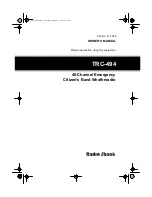
Interface
E1 Spread Spectrum Radios
5-17
Random noise was first regarded as an element that damages the quality and quantity of communicative
signals in communication technology. The random noise in signal channels often distorts the simulated
signal produced or bit error to appear upon the demodulation of digital signals. At the same time, it is also
one of the elements that limit the channel capacity. Consequently, human’s early attempt was to remove
or lessen all the pseudo noise in the communication system. Nonetheless, some of them decided to
obtain all these pseudo noise. For example, communicative equipments or systems testing in laboratory
require an addition of certain noise. So it is necessary to produce/obtain noise here.
In the late 1940s, along with the communication theory, Claude Shannon pointed out that under certain
conditions, for the most effective communications, must adopt signals containing the statistical property
of white noise. Besides, in order to achieve communications of high reliability and privacy, we must use
random noise. However, the biggest difficulty faced in using random noise is that it is not easy to
repeatedly produced and processed. Until the 60’s, the pseudo random noise came about and solve all
these problems.
Pseudo random noise poses statistical property similar to random noise. At the same time, it can be
repeatedly produced and processed easily. It has increasingly been extensively use practically because it
poses the advantages of random noise and none of its disadvantages. In today’s world, it has been
extensively used in digital circuit produced periodic series (after filtering). In the future, this shall be called
the periodic series or the random series.
Pseudo random sequences are generated using a binary shift register with taps that are modulo-2 added
together and fed back to the register's input. The name commonly used for this simple circuit is linear
feedback shift register, or LFSR. Another type is known as the Non-Linear Feedback Shift Registers.
Only certain combinations of feedback taps will result in maximal-length sequences, called m-sequences.
These are the longest sequences possible given a specific shift register size, and they have many
desirable properties. If the register size is m stages, the length of the m-sequence will be 2m-1.
Nowadays, the equipments used are mostly PRBS of m-sequence: x15 + x + 1, 100003.
C4.
Ber-Clear
Clear all accumulated bit error on starting the BER transmission test. Press the OK button.
Figure 5-35 Ber-Clear















































